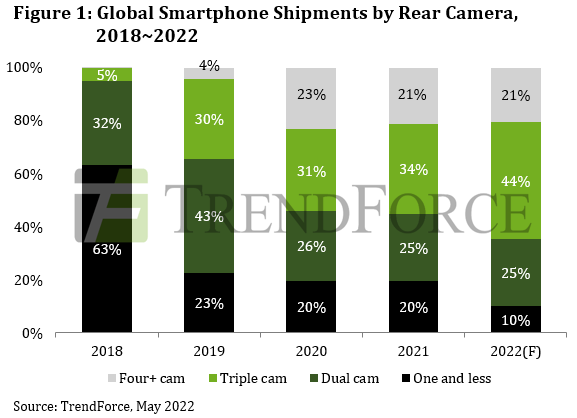
Smartphone camera market to grow at 5% to 5.02 bn, TrendForce reports
According to TrendForce research, smartphone camera module shipments will increase to 5.02 billion units in 2022, an annual growth rate of 5%. Since the price-performance ratio of whole devices is the primary basis for consumer purchases, the cost of high-standard solutions such as the five-camera design and main cameras sporting hundreds of millions of pixels will inevitably be passed on to the manufacturer with little improvement in sales performance.
Therefore, the three-camera module remains the mainstream design this year and is forecast to account for more than 40% of total shipments. Only some smartphone models will adopt a four-camera design to differentiate their specifications, while the number of products with dual-cameras or less will fall, with entry-level models being the primary candidates.

By combining a high-pixel main camera with two low-pixel function cameras, a mobile phone can retain a three-camera design while taking into account hardware costs. TrendForce believes that this is also the primary reason for the development of low-end and mid-range products towards a three-camera or even four-camera design in addition to the increased adoption of low-pixel function cameras including 2-megapixel depth cameras and macro cameras. Growth momentum in mobile phone camera module shipments in 2022 will come primarily from additional numbers of low-pixel cameras prompted by the three-camera design. Although a high-resolution main camera with better specifications allows mobile phone brands to provide better photographic performance, pixel specifications have not continued to climb higher and mainstream cameras linger at approximately 50 million pixels, causing a slight stagnation in demand.
TrendForce indicates that mobile phone brands are currently curtailing competition in the hardware specifications of mobile phone camera modules but remain focused on photographic and video performance as promotional features of their mobile phones and will emphasize dynamic photography, night photography and other scenarios to highlight product advantages. This can be achieved not only by strengthening the optical performance of the camera module itself but also through algorithms and software, thereby increasing the enthusiasm of mobile phone brands to invest in self-developed chips. In addition to Apple and Samsung, which have long used their own SoCs, other mobile phone brands have also tried to launch self-developed chips to enhance image processing performance such as Xiaomi’s Surging C1 and OPPO’s MariSilicon X and VIVO’s V1+.








